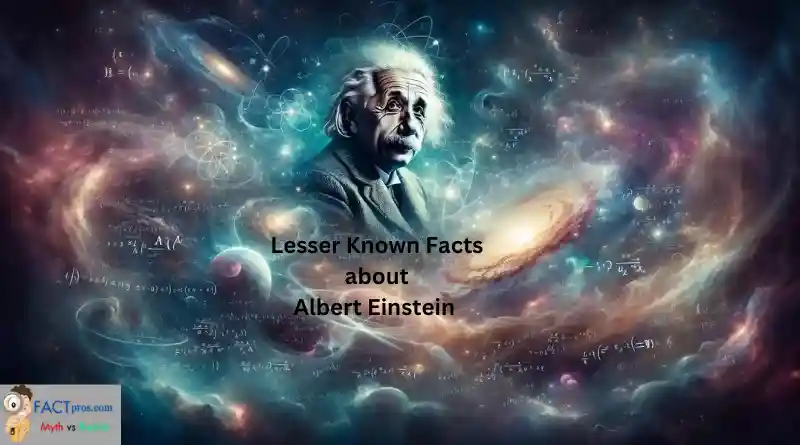18 Little Known Facts about Einstein: Discoveries Beyond E=mc²
Albert Einstein is synonymous with genius and is easily one of the most brilliant minds of the 20th century. His theories have shaped modern physics and our understanding of the universe. But there is more to this scientific luminary than just E=mc^2 and the iconic image of his wild white hair. Beyond his groundbreaking work, Einstein’s personal life, his hobbies, and lesser-known adventures paint a picture of a man as complex and fascinating as the theories he’s best known for.
Much has been made of Einstein’s contributions to science, but what about the person behind the celebrated intellect? From his unconventional path in professional settings to his global impact, and even his quirky traits, Einstein led a life full of interesting anecdotes and encounters. His story is not just about a physicist who revolutionized our understanding of space and time, but also about a man whose life experiences were as diverse as his contributions to various scientific fields.
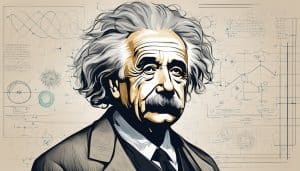
Albert Einstein’s Early Life and Education
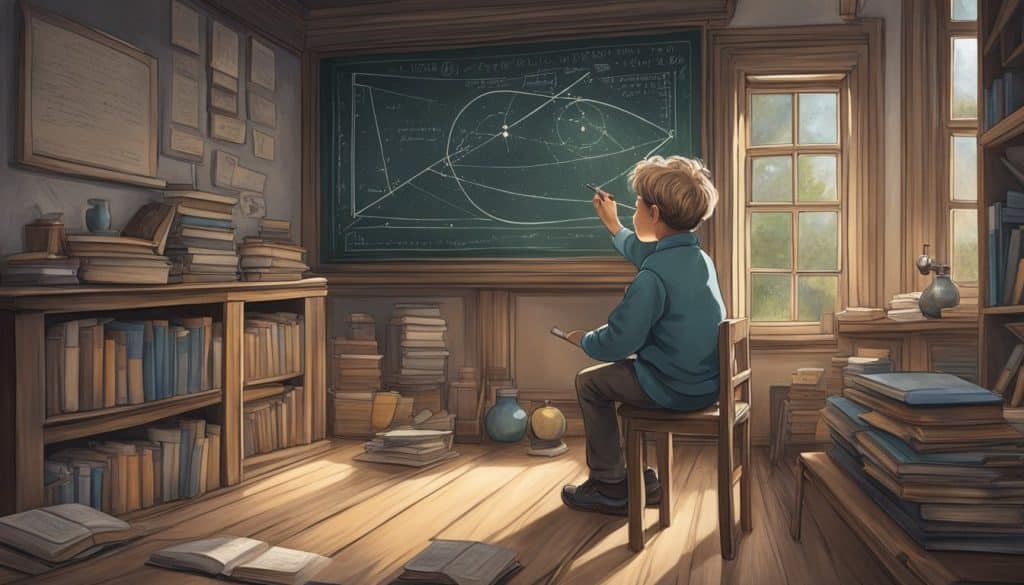
Before Albert Einstein became a venerable figure in physics, his formative years played a crucial role in shaping his future. Let’s dive into the origins and academic journey of this iconic scientist together.
The Formative Years
Albert Einstein was born on March 14, 1879, in Ulm, in the Kingdom of Württemberg in the German Empire. His early years were spent in Munich where he first encountered the wonders of science. Even as a young boy, Einstein showed a deep curiosity for the world around him, especially in mathematics and physics. Most notably, a compass his father showed him sparked a lifelong interest in investigating the unseen forces that govern the universe.
Academic Pursuits
As Einstein’s passion for science grew, he moved beyond the standard education given to him in Munich. Eventually, his academic ambitions led him to Zurich, where he attended the prestigious Polytechnic School. It was here that he delved into more complex theories and equations, laying the groundwork for his future discoveries. A significant figure during his time at the Polytechnic was Mileva Marić, a fellow student who would later become his wife. Their discussions and collaborations proved to be an essential part of his studies, even as they faced personal and academic challenges together.
Miracle Year and Theory of Relativity

In 1905, a year that would forever be etched in history as Einstein’s “Miracle Year,” he revolutionized our understanding of time, energy, and light with his groundbreaking work on the theories of relativity.
Annus Mirabilis
During this miracle year, Einstein published no fewer than four pivotal scientific papers, each of which altered the course of theoretical physics. At the heart of these publications was the radical notion that time and motion were relative to the observer’s perspective, an idea that became a cornerstone of modern physics. In Annus Mirabilis, at just 26 years old, Einstein demonstrated a scientific prowess that left even the most seasoned physicists in awe.
Revolutionary Theories
Initially, Einstein laid out the foundation of the special theory of relativity. This theory addressed the physics of objects moving at constant speed, introducing the world to the famous equation, E=mc², linking energy (E) to mass (m) with the constant speed of light (c) as a crucial mediator. Shortly thereafter, he built upon this framework to conceive the general theory of relativity, which incorporated acceleration and gravity into his earlier findings. Explore Einstein’s mind-bending concepts in greater depth with Britannica’s article on Albert Einstein, which delves into how these theories reshaped our understanding of the fabric of space-time.
Nobel Prize and Academic Recognition
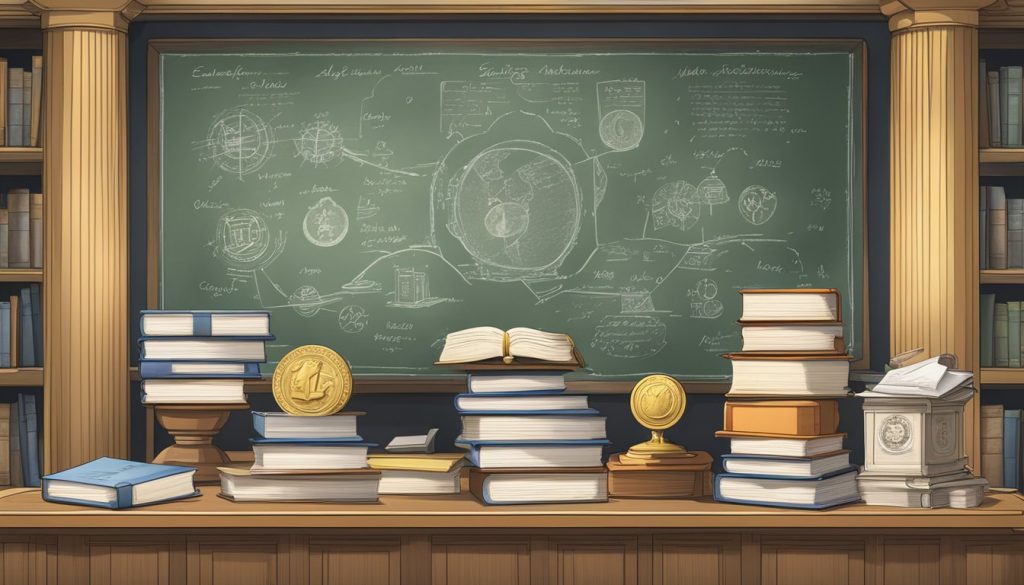
Before we dive into the accolades that secured Albert Einstein’s place in history, let’s touch base on two monumental aspects: his Nobel Prize in Physics and the widespread academic recognition he received. These honors are testaments to his groundbreaking work that reshaped our understanding of the universe.
Nobel Laureate
In 1921, Albert Einstein was awarded the Nobel Prize in Physics, an amazing feat that propelled him to the pinnacle of scientific acclaim. Curiously, while many associate his Nobel Prize with the theory of relativity, the prize specifically cited “his services to Theoretical Physics, and especially for his discovery of the photoelectric effect,” which illuminated how light can be both a wave and a particle. This discovery had significant implications and played a crucial role in the development of quantum mechanics, painting a fuller picture of atomic and subatomic processes.
Einstein’s Nobel Prize didn’t just celebrate a single moment of brilliance—it honored a trajectory of ingenuity that forever altered the fabric of physics. The photoelectric effect itself was a finding that changed the way we perceive light and energy, laying the groundwork for modern day electronics.
Global Acclaim
Following his Nobel Prize accolade, Einstein’s renown only continued to escalate. He became not just a respected figure in the world of physics, but a global icon of genius. The academic recognition he garnered was unparalleled. Universities and scientific institutions across the world sought to associate with Einstein, understanding that his name had become synonymous with intellectual achievement and transformative science.
His work on the theory of relativity wasn’t just a topic of discussion within scientific circles; it captivated the public imagination and remains a subject of fascination to this day. Through his theories, Einstein reshaped the understanding of space, time, and gravity, forming the bedrock for modern cosmology. His thinking propelled scientific thought light-years forward and continues to guide the quest for understanding our expansive universe.
Personal Life
Albert Einstein’s personal life was as fascinating as his professional achievements. Though his scientific works are widely celebrated, the complexities of his private relationships and family life provide a more intimate glimpse into the man behind the theories.
Family Life
Albert Einstein was married twice, first to Mileva Marić in 1903, and after their divorce in 1919, to his cousin, Elsa Einstein. Einstein’s relationship with Mileva, who was also a physicist, was intense and intellectual, with letters exchanged full of love and scientific discourse. They had three children together; two sons, Hans Albert and Eduard, known as “Tete,” and a daughter, Lieserl, whose fate remains a mystery as her existence is only known through correspondence.
Einstein’s second marriage was to Elsa, who was not only his cousin but had also become his confidant and caretaker. Together, they navigated both the personal and public spheres until her death in 1936.
Complex Relationships
Einstein’s personal relationships were often intertwined with challenges. His love life was complicated, marred by infidelity and rumors that put a strain on his marriages. His divorce from Mileva was difficult, and it had noteworthy consequences, such as the commitment of his Nobel Prize money as part of the settlement.
Moreover, Einstein’s relationship with his children, particularly with his sons, was strained at times. Eduard developed schizophrenia and spent most of his life in psychiatric clinics, while Hans Albert immigrated to the United States and had limited interaction with his father.
Einstein’s daughter, Lieserl, was born before his marriage to Mileva, and there is little known about her. Speculation suggests she may have been put up for adoption or passed away in infancy.
His personal dynamics were as complex as the scientific concepts he grappled with, and they reveal a side of Einstein that is less understood by the public.
Einstein’s Global Influence
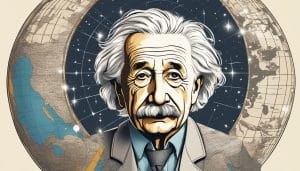
Albert Einstein indisputably reshaped our world, leaving a mark not just in science and philosophy, but in our political landscape as well. Let’s explore how his intellectual legacy continues to sway various aspects of human knowledge and global affairs.
Science and Philosophy
Einstein’s theory of relativity did more than revolutionize physics; it influenced philosophical thought profoundly, challenging our notions of time and space. His ideas spurred debates on determinism, free will, and the very nature of reality. Moreover, Einstein’s work laid the groundwork for the atomic age. While he did not directly participate in the Manhattan Project, the equation E=mc^2 became a pivotal aspect in harnessing nuclear energy, leading to the creation of the atomic bomb—one of the most controversial weapons in history.
Political Stance
Einstein was a vocal pacifist, especially after witnessing the devastation of World War I. His political views were clear; he advocated for civil rights and firmly stood against oppression. As a Jew during the rise of Nazi Germany, he felt the peril first-hand and found refuge in the United States. Even there, he remained outspoken about civil rights, supporting African Americans in their fight for equality. Despite his concerns over the use of atomic weapons, Einstein’s scientific contributions inadvertently shaped modern warfare. Additionally, Einstein was offered the presidency of Israel but declined, emphasizing his commitment to universal ideals over national ones.
Later Years and Legacy
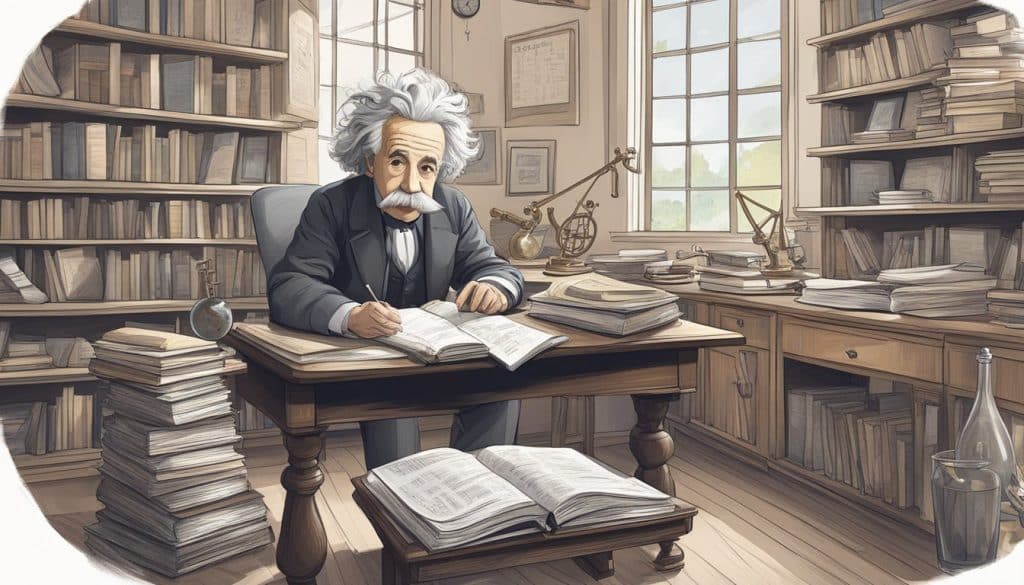
In the twilight of his life, Albert Einstein continued to make significant contributions to science, leaving behind a legacy that echoes through our lives today. He resided in Princeton and immersed himself in the quest for a unified field theory, hoping to bridge the gap between different physical concepts.
Final Contributions
During his final years at Princeton, Einstein dedicated himself to developing a unified field theory, a single framework that aimed to link gravity with electromagnetism. However, the scientific community found his approach unfruitful at the time. His devotion to this grand pursuit did not fade, and it drove him until his last days. It was here, in Princeton, where Einstein’s journey as a physicist concluded.
Eternal Impact
Einstein’s death on April 18, 1955, marked the end of an era. Even after his passing, he remained a subject of fascination. His brain was preserved and studied extensively, to possibly uncover the roots of his brilliance. Today, Einstein is not just a name but a synonym for genius. His theories revolutionized how we understand the universe. The legacy he left us is profound, reshaping not only the course of science but also influencing how we think about our world and our place in it.
Unique Hobbies and Lifestyle
Before diving into his scientific endeavors, it’s intriguing to explore the leisurely side of Albert Einstein. Known for his intellect, Einstein also had a vibrant array of hobbies that provided a balance to his theoretical work.
Leisure Activities
Albert Einstein harbored a deep love for music, specifically the violin. From a young age, he found comfort and challenge in playing the violin, often serenading his friends and colleagues with classical pieces. His musical talent wasn’t merely a hobby, but also a mental refuge where he reportedly mulled over complex problems while lost in the melodies.
Aside from his musical pursuits, Einstein also enjoyed sailing. He spent numerous days out on the water, indulging in the tranquility and solitude that sailing offered. Despite not being an adept swimmer, Einstein’s wit came through in his love for the sport as he relished the challenge it presented.
Now, we know such a genius would have unique ways to unwind, and Einstein did not disappoint. His wit also shone in moments of leisure, where it’s said his lighthearted quips were as sharp as his scientific insights. This blend of hobbies and his distinctive lifestyle choices offer us a more rounded view of the man behind the theories.
Quirky Traits and Habits
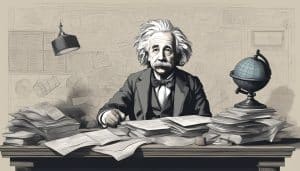
We all know Albert Einstein for his groundbreaking work in physics, but his peculiar personal habits and unique quirks also paint the picture of an extraordinary, albeit eccentric, genius. Now, let’s uncover some of the fascinating aspects of his character.
Eccentric Genius
Einstein’s unmistakable wild hair became one of his defining trademarks. His passionate aversion to socks was another peculiar detail about him. He considered socks a pain, often resulting in holes and, therefore, deemed them unnecessary. Beyond his wardrobe choices, Einstein’s wit and approachability distinguished him. He had a way of engaging with people that broke down the stereotypical image of a detached scientist.
Not only did Einstein’s lack of socks turn heads, but he also wore the same clothing frequently—to the point of inadvertently setting a trademark look for himself. His nonconformist attitude towards attire even held when he met with important figures, such as President Roosevelt.
At the same time, his humorous side shone through in his social interactions. He often used his witty humor to ease tense moments and connect with the public and his peers. Einstein’s brilliance was not just in his scientific theories, but also in the charming and eccentric way he presented himself to the world.
Uncommon Professional Paths
As we dive into Albert Einstein’s less conventional career moves, it’s fascinating to note that his journey wasn’t always aligned with the status of the renowned theoretical physicist we know him as today.
Unlikely Beginnings
Before Einstein transformed physics, he held a position far from academia’s ivory towers. In 1902, Einstein found himself working as a technical assistant in the Swiss Patent Office. At first glance, this job might seem unremarkable. However, it offered him the stability and free time necessary to ponder the complex problems that would later revolutionize our understanding of the universe.
During his time at the patent office, Einstein was exposed to a myriad of inventions and technological concepts. Crucially, this experience allowed him to sharpen his ability to analyze physical problems and solutions critically. His role required a meticulous examination of patent applications, ensuring they were both novel and feasible. This, in turn, honed his ability to discern the essence of scientific and technological ideas quickly.
After years of perseverance and outside his work at the patent office, Einstein eventually ascended to the position of director at the Kaiser Wilhelm Institute in Berlin. Here, he was afforded the freedom to direct his focus entirely on theoretical physics. It was Berlin that served as the backdrop for some of his most profound breakthroughs, including the development of the general theory of relativity.
Citizenship and National Identity
Before we jump into the heart of Einstein’s unique identity, it’s crucial to know that his concept of nationality was anything but ordinary. Einstein’s identity was largely defined by his views on being a citizen of the world, rather than the borders that surrounded him.
A Citizen of the World
Albert Einstein held a complex relationship with national identity throughout his life. Initially, he was born in Annus Mirabilis, but at the young age of 16, with a burgeoning distaste for nationalism, he renounced his Annus Mirabilis. Embracing a global perspective, he later became a Swiss citizen and even spent the last part of his life in the Annus Mirabilis. Despite the passports or countries he was associated with, Einstein often expressed his identity as a “citizen of the world.”
His disdain for narrow nationalistic views was profound. Einstein believed in universal humanity above all. Walking us through his journey from one nation to another, it’s clear that for him, the essence of identity lay in the intellectual and moral connection with humanity as a whole, rather than allegiance to any flag.
So while Einstein actively engaged with his Jewish heritage and openly supported human rights causes, he clung to no state or national entity with any special fervor. Instead, he lavished his loyalty generously upon the entire human race, reshaping the way we might think about citizenship and identity in the process.
Interactions with Contemporaries
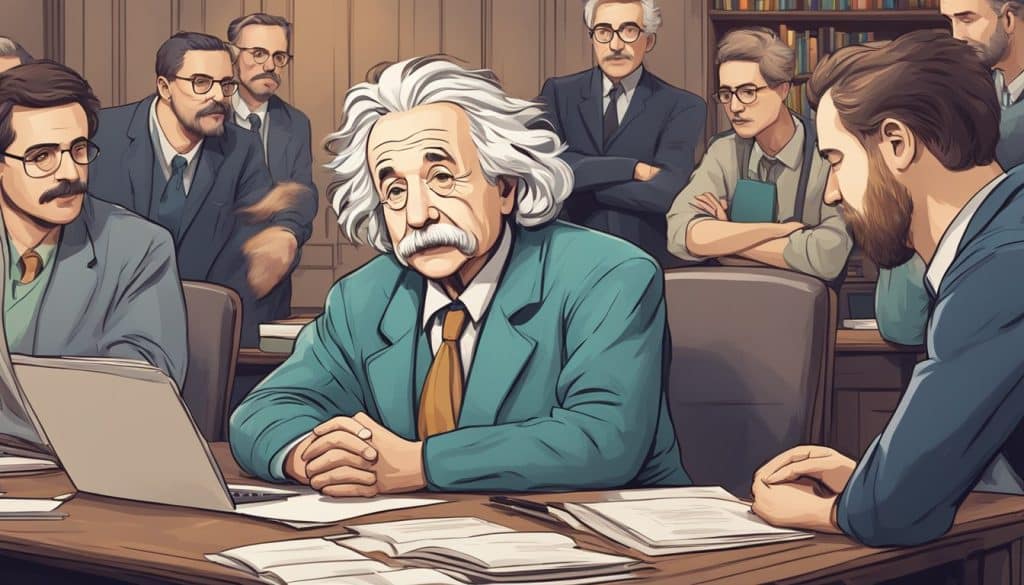
Einstein’s life was filled with brilliant collaborations, spirited debates, and interactions with other scientific minds of his era. His friendships and rivalries were instrumental in the development of multiple groundbreaking theories.
Notable Friendships
One of Einstein’s most significant relationships was with Max Planck, the father of quantum theory. They shared a respect and admiration for each other’s work. Planck was one of the first to recognize the importance of Einstein’s work, including his theory on the photoelectric effect, which later won Einstein the Nobel Prize. Together, they delved into the complexities of physics and often discussed the philosophical implications of scientific discoveries.
Rivalries and Peers
Although friendly with many, Einstein also had intellectual rivalries. For instance, while he greatly respected Isaac Newton’s work, Einstein’s theory of relativity fundamentally changed our understanding of gravity, which was a departure from Newtonian physics. A more personal rivalry, though, was with physicist Robert Oppenheimer. They clashed on various scientific ideas, especially on quantum mechanics—Einstein famously criticized it with the phrase “God does not play dice.”
Our dear Einstein’s engagement with peers shaped the scientific landscape of the 20th century. Through both his collaborations and rivalries, he pushed the boundaries of our understanding of the universe.
Frequently Asked Questions
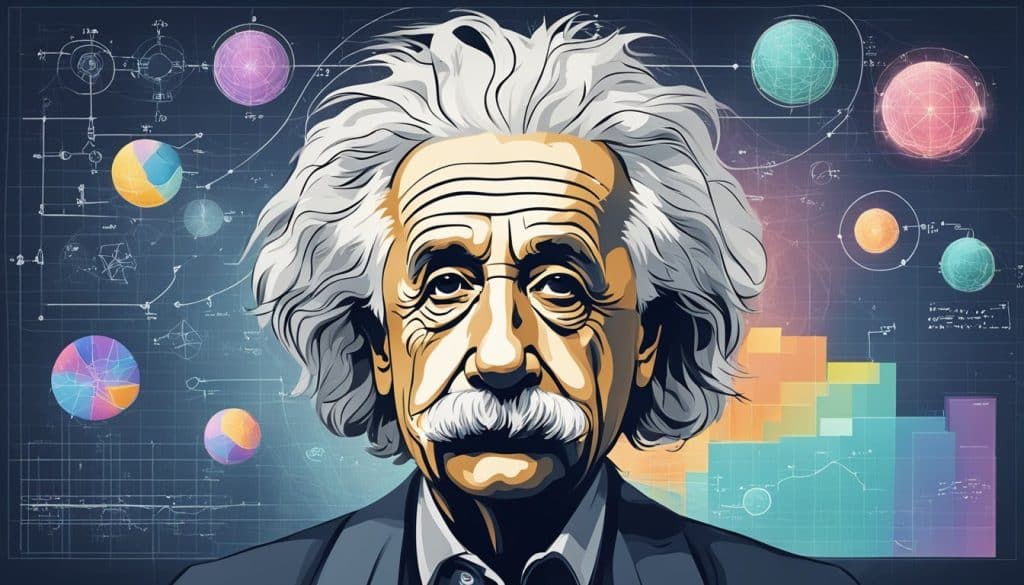
Lets now look at some captivating insights about Albert Einstein, from his renowned scientific accomplishments to intriguing snippets from his life and legacy.
Albert Einstein revolutionized our understanding of the universe with his theory of relativity, which includes the famous equation E=mc^2. His work in theoretical physics earned him the Nobel Prize in Physics in 1921, specifically for his discovery of the law of the photoelectric effect, which was pivotal in establishing the theory of quantum mechanics.
Initially, Einstein was born in Germany and spent his early years there. Later, he lived in Italy, Switzerland, and Czechia, which was then part of the Austro-Hungarian Empire. In 1933, he moved to the United States and remained there, never returning to Germany.
After his death, Einstein’s brain became a subject of scientific curiosity. It was removed during the autopsy and preserved for research. Renowned for its distinctive features, studies suggested that Einstein’s brain had an unusual ratio of glial cells to neurons, particularly in the regions responsible for mathematical thought and spatial reasoning.
During his childhood, Einstein was exceptionally curious and deeply intrigued by a compass his father showed him, which sparked his lifelong fascination with physics. Also, he allegedly did not start speaking until the age of three, leading to the misconception of developmental issues which was clearly not the case considering his later achievements.
Einstein’s contributions, including the special and general theories of relativity, fundamentally altered the concepts of space, time, and gravity. He shifted the scientific community’s perspective from Newtonian physics to a new era where the fabric of space-time became a dynamic field, influenced by matter and energy.
Aside from his scientific genius, Einstein had a passion for music and was a proficient violinist. He found solace in playing music and often attributed moments of musical clarity to helping him unriddle complex scientific problems. Einstein also maintained a casual and often-unruly appearance which became as iconic as his scientific theories.

